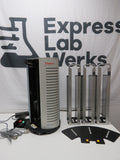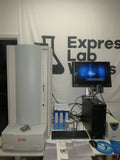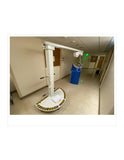Shimadzu UV-1800 Double Beam UV/Visible Scanning Spectrophotometer - Exceptional
Web Information
Specifications & Description
- Stray Light<0.02%T at 340 nm, 400 nm; <1.0%T at 198 nm
- Source LampDeuterium; Tungsten-Halogen
- Source Lamp Life2000 hours
- Beam TypeDouble
- Bandwidth1.0 nm
- Min Wavelength (nm)190
- Max Wavelength (nm)1100
- Wavelength Accuracy±0.1 nm
- Wavelength Reproducibility±0.1 nm
- Min Photometric - Transmittance (%T)0
- Max Photometric - Transmittance (%T)400
- Min Photometric - Absorbance (A)-4
- Max Photometric - Absorbance (A)4
- Photometric Drift<0.0003 A/hr
- DetectorSilicon photodiode
- OutputUSB
- Display TypeLCD (4.75" x 3.5")
- Width (cm)45
- Height (cm)49
- Depth (cm)26
- Width (in)17 45/64
- Height (in)19 19/64
- Depth (in)10 1/5
- Power (Hz)60
- DescriptionUV/Visible Scanning Spectrophotometer; 115 VAC
More About this Item
The UV-1800 is an advanced high-resolution spectrophotometer utilizing a precision Czerny-Turner optical system. Operation can be either as a stand-alone instrument or as a PC-controlled instrument with the included UV Probe software. USB memory can be connected directly to the UV-1800 for simple data transfer and printing is possible with the optional screen-copy printer or printers that support PCL control codes.
Photometric Mode measures the absorbance or transmittance at a single wavelength or at multiple (up to eight) wavelengths. In multiple-wavelength measurement, calculations can be performed on the data obtained for up to four wavelengths, including the calculation of the difference between, or ratio of, the measurements obtained for two wavelengths.
Spectrum Mode obtains sample spectra using wavelength scanning. Changes in the sample can be tracked using repeated scans. Data processing operations, such as the enlargement or reduction of the spectra obtained, peak detection, and area calculations, are also possible.
Quantitation Mode generates a calibration curve from standard samples, and uses it to calculate the concentrations of unknown samples. Various combinations of wavelengths (1 to 3 wavelengths and derivatives) and calibration curves (K-factor and first-to-third order regression calibration curves) are possible.
Kinetics Mode measures the change in absorbance as a function of time, and calculates enzymatic activity values. You can select either the kinetics measurement method or the rate measurement method.
Time-Scan Mode measures the change in absorbance, transmittance, or energy as a function of time.
Multi-Component Quantitation Mode separately quantitates up to eight components mixed in a single sample. Pure components or mixtures of components can be used as standard samples.
Biomethod Mode is capable of analyzing DNA and proteins using the several common quantitation methods including quantitation of DNA or protein using the absorbance at 260/230 nm or 260/280 nm and protein quantitation via the Lowry method, BCA method, CBB method, Biuret method, and UV absorption method (direct measurement at 280 nm).
Security and validation functionality are also preprogrammed. Security functions allow you to restrict functions according to three user levels: administrator, developer, and operator. Automatic or semiautomatic validation functions include wavelength accuracy, wavelength repeatability, resolution, stray light, photometric accuracy, photometric repeatability, baseline flatness, baseline stability, and noise level. The operating time of the lamps can be recorded and displayed so that you can anticipate replacement and avoid downtime.
Condition
Exceptional condition! Instrument verified with Holmium Oxide reference. Absorbance verified using G1 standard per chart in photos. Please note, UV probe software for external PC is not included in this sale.
Includes
- Shimadzu UV-1800 Double Beam UV/Visible Scanning Spectrophotometer
- Power cord
BBOR
Warranty
30 Day warranty. We pledge to offer the best service and warranty to all of our customers! We are extending a 30 Day warranty on this item. This is our way of saying thank you for allowing us to serve you.
Certification
This is a genuine product from this manufacturer.
Disclaimer
The sale of this item may be subject to regulation by the U.S. Food and Drug Administration and state and local regulatory agencies. the item is subject to FDA regulation, we will verify your status as an authorized purchaser of this item before shipping of the item."
Regardless of the origin of the equipment, documentation provided or identification appearing upon the equipment, the equipment described and offered here is in no way certified for, recommended for, or offered for any specific use. The purchaser agrees that the seller shall not be held responsible or liable for any injuries or damages, whether incidental or consequential, associated in any way with the equipment. The purchaser, by bidding on this equipment, indicates their acknowledgment of, and agreement to the terms of this disclaimer. it is the purchaser's responsibility to have the item inspected and certified by a qualified professional before use!



















